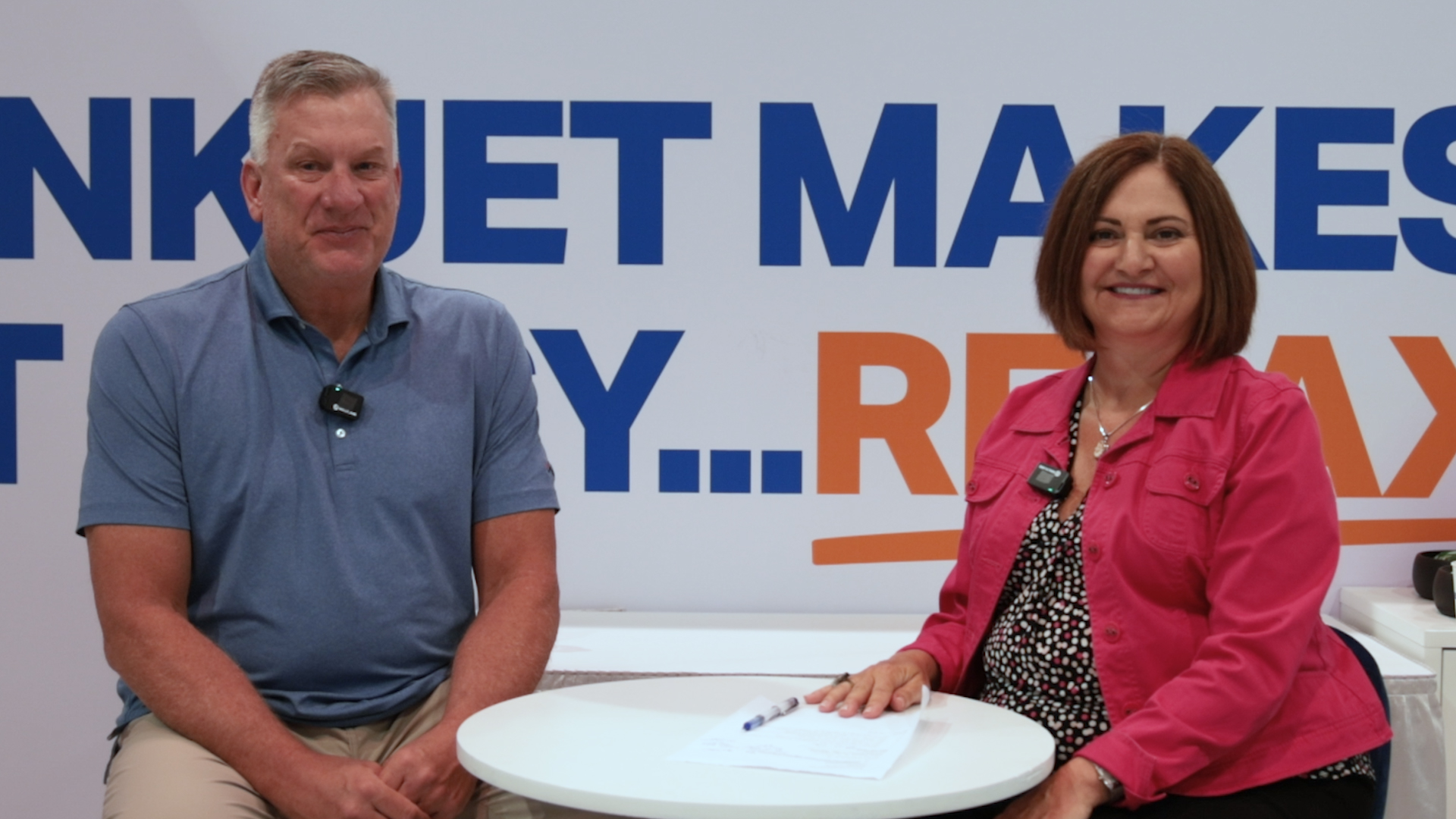Frank's Walk in the PARC
Frank reports that Xerox has donated its Palo Alto Research Center (PARC) to another research organization, ending decades of research into advanced communication technologies. The Graphical User Interface changed the way we worked on computer screens, but other companies, primarily Apple, commercialized it.
 Official camera partner of WhatTheyThink and the drupa daily. Video from drupa 2024
Official camera partner of WhatTheyThink and the drupa daily. Video from drupa 2024
Video Center
- Questions to ask about inkjet for corrugated packaging
- Can Chinese OEMs challenge Western manufacturers?
- The #1 Question When Selling Inkjet
- Integrator perspective on Konica Minolta printheads
- Surfing the Waves of Inkjet
- Kyocera Nixka talks inkjet integration trends
- B2B Customer Tours
- Keeping Inkjet Tickled Pink
© 2024 WhatTheyThink. All Rights Reserved.















Discussion
By Joe Treacy on May 19, 2023
Frank, it was great fun to see you moderating the page description language (PDL) “shoot-out” between Xerox and Adobe.
That packed-room event (1981 or ‘82?) decided which PDL would — as you say — define the future. And, it turned out, not just within the graphic arts.
Adobe soon found out that it could do far more than merely replace the daisy wheel and golf ball typewriters.
I knew when I’d seen the notice of the upcoming shoot-out event (probably in The Seybold Report) that I just had to drop everything, get on a plane, and be there.
It was a history-making event, and Frank, you were at the center of the maelstrom, getting ahead of it all, and helped guide us to clarity. Thank you!
And what an amazing graphic arts future it became! What a ride.
I’m forever grateful to Mssrs. John Warnock and Charles Geschke for understanding is was time to exit and transcend the inventive PARC.
And, of course, I’m grateful to Mr Jobs for taking an interest in calligraphy which brought “fonts” into the Lisa, and then quickly pivoting all that wonder into Macintosh. That was some pivot!
What an incredible time the late ‘70s through the mid-‘90s was, enabling independent type designers to break free from the former closed systems, and (as much as I truly love all the people at all the trade typesetting shops and pre-press houses I worked with and who put up with my endless fussiness), for truly putting design and full composition control back into the hands of designers.
You all enabled my shape-shifting future from graphic designer and creative director, to type designer and even digital photo-illustrator.
I thank you all.
By Gordon Pritchard on May 19, 2023
I don't believe that the Alto system was ever intended to be a commercial product. Instead Xerox released the Star system, ca 1982, which was a commercial product that used their graphical interface. I think that's what Jobs saw during its development.
By David Blatner on May 19, 2023
Gordon is correct: the Alto was the "beta" product, as it were. However, I am pretty sure Jobs did see the Alto computers at PARC, as they were everywhere. I like to say that I worked at PARC around 1979, but the truth is that it was just an unpaid internship I got mostly because I was a nerdy kid and my step-dad worked there! But I loved signing in at the front desk and getting my little badge with my name on it.
I learned the fundamentals of what later became "desktop publishing" on the Alto — from page layout to selecting fonts in a WYSIWYG environment. I still have stuff I produced and printed on the enormous Xerox laser printers (often called "line printers" at the time). They even had a color drawing program called Gryphon and a color laser printer that must have cost a bazillion dollars back around 1980. Little did they know this kid was printing out all kinds of silly drawings.
Now here's the crazy part: Xerox seems to have donated PARC to SRI… which is where my step-dad worked before PARC! SRI is where the mouse was invented. I remember seeing it when I was like 10 years old, along with an electric piano keyboard hooked up to a computer (this was long before MIDI, etc)
Thank you Frank and Joe for this incredible trip down memory lane!
By Dov Isaacs on May 19, 2023
Steve Jobs from Apple wasn't the only one who saw what Xerox was doing at that time. I was part of a team from Wang Labs (remember them from the 1970s and 1980s, originally known for calculators and then word processors and minicomputers) who visited Xerox to get a “tour” of the Xerox Star workstation in California. We definitely saw that as the future (albeit, the Star had some very critical shortcomings such as its lack of integration with other office and computer-based activities). We also saw the Lisa when it first came out. Given how overpriced and underpowered the Lisa was, at Wang we saw an opportunity to incorporate the user interface and graphics of the Star and Lisa with true advanced document creation/editing and office functionality with reasonable size high resolution monitors, mice and touch screens, the Motorola 68010/20 processors, network interfaces, compatible file servers, etc., all layered over Unix System V.
Regrettably, although we had the full support of Dr. An Wang, his number one son, Fred (who was anointed as Dr. Wang's successor – isn't nepotism great?), couldn't see a future beyond 64k memory Z80s and 24x80 character screens. By the end of 1983, the team working on the future Wang system (targeted for 1985-86 delivery) all left Wang for other companies due to the lack of support from Fred Wang. (I ultimately ended up at Adobe!) We all know what regrettably happened to Wang. Very sad!
The high tech industry is regrettably littered with companies that couldn't and/or wouldn't move on to the future. Xerox was a particularly grievous example of this. Not only did they have PARC, but they also acquired SDS (Scientific Data Systems) known for its high-end computer systems. In the end, in terms of what the rest of the industry saw, every time Xerox executives were presented with new technology, if it didn't relate to copiers (i.e., “Xerox machines”), the assets were essentially abandoned.
- Dov
By Frederic Kelley on May 20, 2023
Thank you for the start down memory lane: My Xerox Star to Mac Path
In 1981 did several advertising projects as art director/designer with a writing consultant who had a contract with Versatec, a division of Xerox making wide-format printer/plotters for engineering. After a couple of projects, we were asked to work on something new, a workststion called the Xerox 8010 Info System. “Star” was the software designed to run on the system, but soon the system became known as “Star.”
Being a print art director/designer, I was fascinated by what I saw. We did one ad which ran I don’t know where. 2 years later, a long-time tech client showed me his new acquisition, an Apple Lisa. I knew how the mouse worked having seen the Star and sure enough Lisa was cool! He let me play a bit but at $10K I wasn’t interested because other than being cool, it was an expensive toy.
A young woman had approached my partners and me and several times in the late ’70s and early ’80s about working for our design firm. She had a PhD in Art History and we told her that paste-up was all we could offer and that it was far beneath her and she’d be bored. One day I received a call from her to tell us the good news that she was no longer interested in a job with us because she’d been hired at Apple. I asked her, “Susan, what will you be doing there?” She answered that she couldn’t tell me because it was a secret project. I pushed a bit and she added, “All I can tell you is it’s nickname, ‘Macintosh.’” I remember telling her, “Oh, I get it, named after the Macintosh Apple, like a Granny Smith . . . ” (Susan’s last name was “Kare,” which may ring a bell with some who read this. She was the graphics mastermind behind MacDraw, which I believe was the application that really “sold” the new machine).
When first available, the Macintosh was only sold through personal computing stores carrying the IBM PC, the Apple II and several others as the Apple stores were years away. I bought one of the first sold in Palo Alto, CA at ComputerWare, a small one-off store.
Several years after I bought it, Adobe’s Postscript came on the scene and it changed, well, everything in the design world after Apple released their Laserwriter, and others developed all sorts of applications. Once the bases were covered by Quark XPress and Adobe Illustrator, I never looked back at the “conventional” design studio tools. Then, Photoshop was released and closed the loop for me. Several years later I closed my studio and moved to a rural area by the coast where I still run my design business.
FH Kelley
By David Blatner on May 20, 2023
FH Kelley: That is such a great story… I also bought my 128K at ComputerWare, too… I still have it. It powers up, but there's some bad memory or something so it gives a sad-mac face.
By 1986, I was working for Vince Dorn at LaserWrite in downtown Palo Alto… did you know it? It was a summer job during college, and I was processing film on the Linotronic 100, learning PostScript, troubleshooting people's crazy PageMaker files, and then… suddenly a QuarkXPress disk showed up. And the rest was history.
By Frederic Kelley on May 27, 2023
David,
I vaguely remember the name LaserWrite. You mention PageMaker I believe you meant RageMaker. That was the name Tim Gleaves of CBM Type in Sunnyvale gave to his nemesis from Aldus.
My QuarkXPress Story:
I stumbled upon Quark by chance before its release at Macworld 1987. They didn’t have a booth per se, more a card table but there was an enthusiastic crowd gathered so I joined them watching demos. I too became enthusiastic after just a few minutes. I don’t remember how or why but I went home that day with a disk. I figured it out rather quickly. It put PageMaker to shame.
I had a client project just starting, a brochure of 12 or 16 pages for a Silicon Valley client of mine. I designed the piece and printed 11x17 signature proofs on my laser printer for client approval. All good until I sent the files to CBM for output — there was no driver for the imagesetter on that disk from Quark. So, I rebuilt the file in Pagemaker because I had a deadline and no idea how to proceed with Quark. I’ve been an early adopter all along and sometimes I’ve payed a price for being first on my block!
When the official release was available I jumped on it. I’m still a Quark user today because I learned the program and can set type without thinking about each move. I have InDesign, and have had it since Adobe made it part of their subscription model. I use their imaging tools but I’ve never used InDesign, and don’t want to have to learn another application for page layout.
By Joe Treacy on May 27, 2023
Hi, Frederic — We started using QuarkXpress around 1987 when Aldus PageMaker started creating extra “ghost text boxes” that couldn’t be omitted.
We loved QuarkXpress and still use it today. It’s great.
We use other software such as Adobe Illustrator and sometimes Adobe InDesign, too. But we really enjoy using Xpress.
Remember what fun it was to send a job (even a minimal job) to the “version 23” Apple LaserWriter in those day?
Send it and go home for the night, only to find out more than half the time that it had timed out. And, we leased it for like $8k.
The following Apple LaserWriter II NTX fixed all that and was fantastic. Its industrial design was groundbreakingly stylish, too. I used it for many years.
Those were the days!
By Frederic Kelley on May 28, 2023
Those were the days. It was magic compared to how I started out in the design business, though it forced us to be very resourceful, and . . . patient.
Discussion
Only verified members can comment.